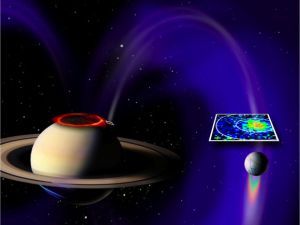The ringed planet and one of its strangest moons are linked by an electrical circuit, igniting an ultraviolet glow in a patch of Saturn's atmosphere,
NASA scientists reported Wednesday.
The electrical connection, suspected by scientists and confirmed by the Cassini spacecraft, forms an enormous arc, from a "footprint" the size of California in Saturn's northern hemisphere to the moon Enceladus, some 150,000 miles away.
A corresponding arc from the moon to Saturn's southern hemisphere likely completes the circuit, but has not yet been seen.
"We've got this first, visual depiction of Enceladus interacting with Saturn," said Marcia Burton, a fields and particles scientist at the
Jet Propulsion Laboratory who is on the Cassini team but did not work on the Enceladus study.
Enceladus is an oddball in its own right. It is famous for being the only moon in the solar system that sprays jets of water and organic particles from its surface into space.
The jets, in fact, form a plume of "plasma" -- charged particles -- that interacts with Saturn's magnetic field, causing the patch of ultraviolet light on Saturn to flicker.
"This gives us some sort of idea of how the Enceladus plume varies over time," Burton said. "The flickering is related to the plume waxing and waning."
The electrical connection also creates a radio "hiss" recorded by Cassini.
Io, a volcanically active moon orbiting Jupiter, also creates shining footprints in Jupiter's north and south poles, so scientists suspected Enceladus might do the same on Saturn.
Cassini, a probe that has been investigating the Saturn system for the past six years, first picked up signs of beams of protons near Enceladus that were aligned with Saturn's magnetic field.
Scientists then traced the likely path of the beams to Saturn, and, in 2008, found their ultraviolet patch -- almost exactly where they predicted it would turn up.
Saturn also has its own northern lights, which can be seen in visible light, but they are separate from the ultraviolet patch created by the link with Enceladus.
Magnetic field lines are behind both planets' auroras. They drive charged particles into the atmosphere at the poles, which flicker and dance with light as they strike atmospheric particles.
The study was published online Wednesday in the science journal,
Nature.

Reader Comments
to our Newsletter